Chapter 4. Reference Architecture
The architecture of an enterprise can involve hundreds or thousands of processes that play out against the enterprise’s architecture pattern. Documenting each of these processes individually can be a daunting task. However, it is commonplace for many processes to follow similar patterns: The work has a similar structure and this structure is mapped consistently onto the architecture pattern. In such cases these processes can be documented by capturing their common pattern in a reference architecture.
Comparing the architecture of one enterprise against the architecture of another can be similarly complex. The details of individual processes and architecture patterns are frequently different, yet often their structure is similar. Once again the similar structure can be captured and shared in the form of a reference architecture.
So what is a reference architecture? It is simply an abstracted architecture (Figure 4-1). The reference process model shows the abstracted structure of the work process. The reference architecture pattern shows the abstracted structure of the process participants.1 The process-pattern mapping shows how the abstracted process maps onto the abstracted architecture pattern.
Figure 4-1. Essential Aspects of an IT Reference Architecture
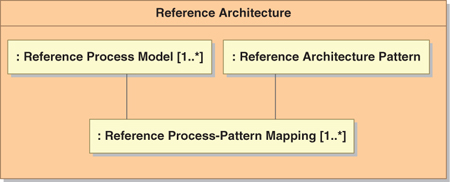
Reference Process Model
The reference process model is an abstracted version of the process. Figure 4-2, for example, is an abstracted version of the process shown in Figure 3-3. The abstracted process has exactly the same structure as the more detailed model, and the artifacts that are passed are abstractions of the artifacts passed in the more detailed model. This similarity of structure is an essential element of the reference process model. The similarity ensures that reasoning about the reference model also applies to the more detailed models.
Figure 4-2. Reference Process Model Example
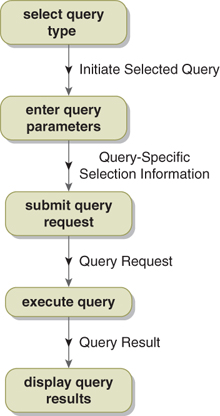
Reference Architecture Pattern
The reference architecture pattern is an abstraction of the architecture pattern. For example, Figure 4-3 is an abstracted version of the architecture pattern shown in Figure 3-5. Note that the structure is exactly the same. Structural similarity is an essential requirement both in abstracting a reference architecture pattern and in creating an actual architecture pattern from a reference architecture pattern.
Figure 4-3. Reference Architecture Pattern Example
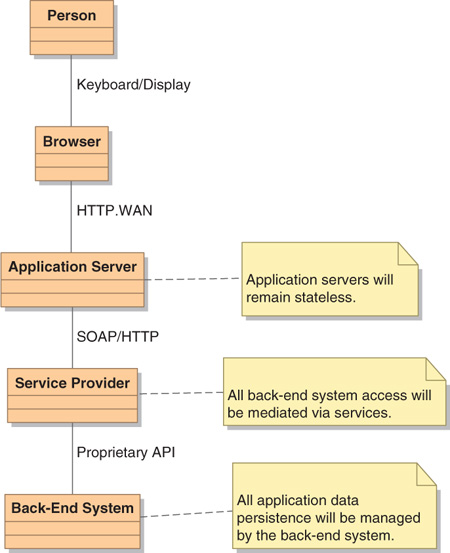
Reference Process-Pattern Mapping
The process-pattern mapping for the reference architecture (Figure 4-4) is what you would expect: a mapping of the reference process model onto the reference architecture pattern. The mapping makes clear which participants are responsible for which activities and, when activities are split across multiple participants, the roles of those individual participants. Once again, the structure must be the same as that of the mapping being abstracted.
Figure 4-4. Reference Process-Pattern Mapping
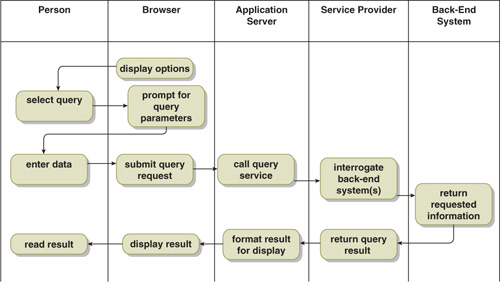
Applications of Reference Architectures
Reference architectures abstract common features from ordinary architectures. In so doing, they provide a means of showing common structure across these architectures. This can be useful in a number of circumstances:
• Simplifying the documentation of a number of processes that all share a common structure and are mapped onto a common architecture pattern. The reference architecture allows a single process model and a single mapping to document the collection of processes with the same structure.
• Sharing a design pattern across different architectures. In these cases the reference architecture captures the common work structure and an abstracted architecture pattern.
• Specifying the preferred approach to solving a particular kind of problem. In these cases the reference architecture captures the work structure common to solving the problem and illustrates how the work structure should be mapped onto a particular architecture pattern.
This last circumstance is an important one in the enterprise, for it provides a means for enterprise architects to communicate preferred approaches to project architects. In these cases the architecture pattern is typically quite specific, indicating the actual types of components required within the enterprise. In contrast, the process model is more abstract, covering a family of processes with similar structure. For example, the enterprise architects may wish to specify how queries (Figure 4-2) should be performed with the enterprise’s preferred architecture pattern (Figure 3-5). The resulting mapping would look like Figure 4-5, mapping a generic process onto a specific architecture pattern.
Figure 4-5. Reference Architecture Mapping with a Specific Architecture Pattern
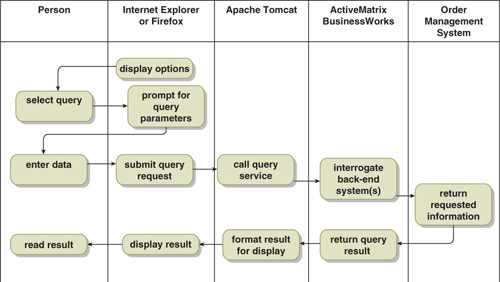
Summary
A reference architecture is an abstracted version of an architecture. It has the same structure as an architecture, with process models, an architecture pattern, and a mapping of each process model onto the architecture pattern. The difference is that each process model depicts the abstracted structure of a set of actual processes and the architecture pattern depicts a (possibly) abstracted structure of the participants and their communications channels.
Because reference architectures abstract structure, they provide a convenient means of communicating structure without having to be tied down to specifics. They are useful for summarizing the structure of related processes, comparing structure between different architectures, and communicating preferred design patterns.
